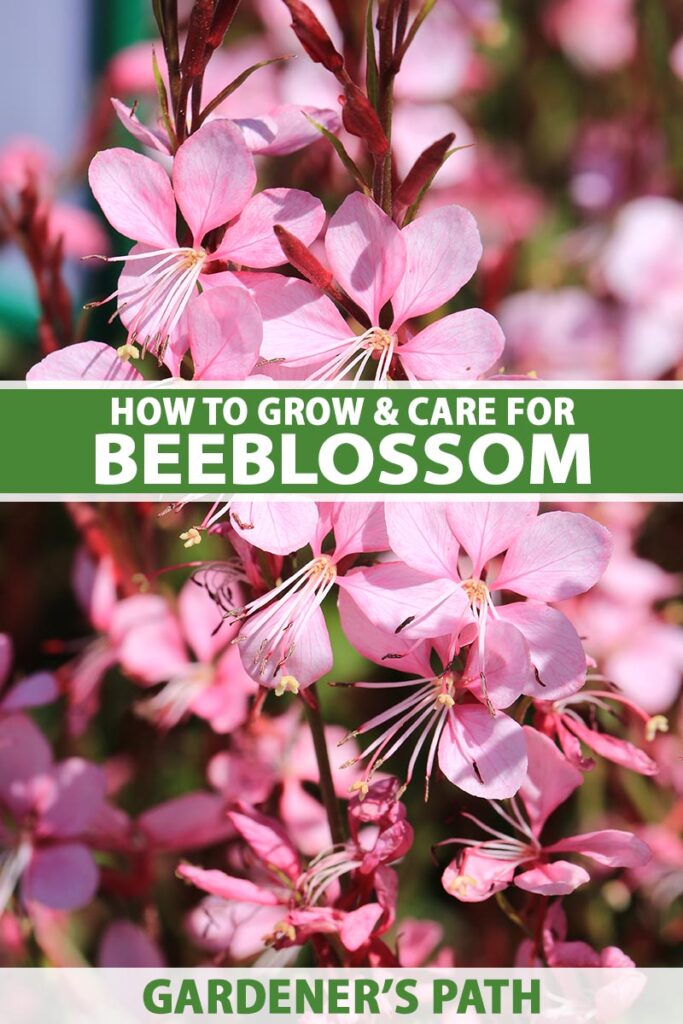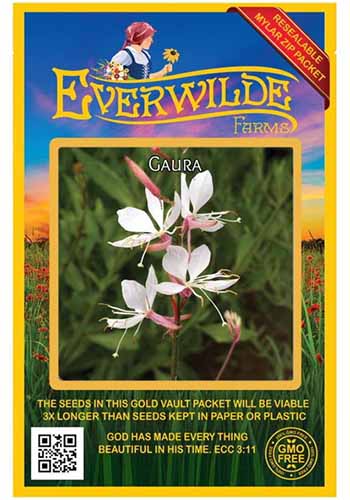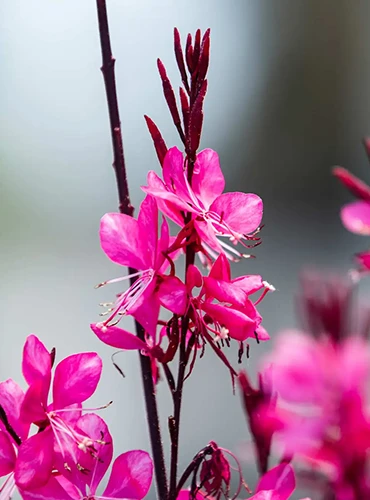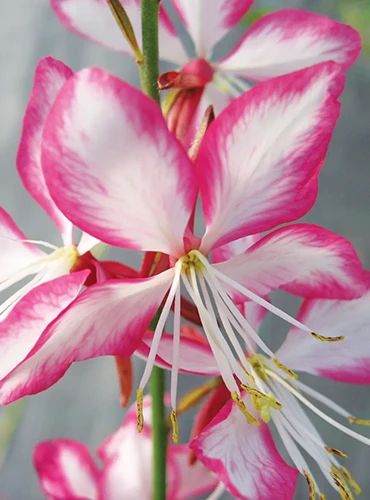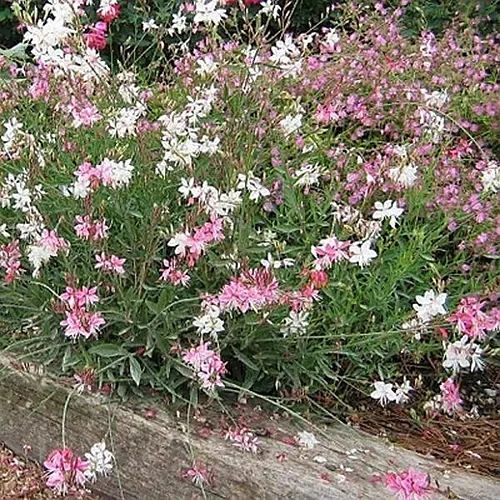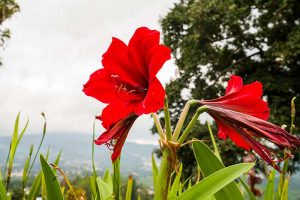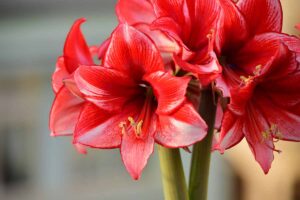Oenothera lindheimeri (syn. Gaura lindheimeri)
Showy and low maintenance, gaura, also known as beeblossom, is a North American native that’s highly popular as a cultivated wildflower.
Plants have an open form, with long, waving wands dotted with delicate, fluttering flowers and deep, rosy buds that rise above dense clumps of dark foliage.
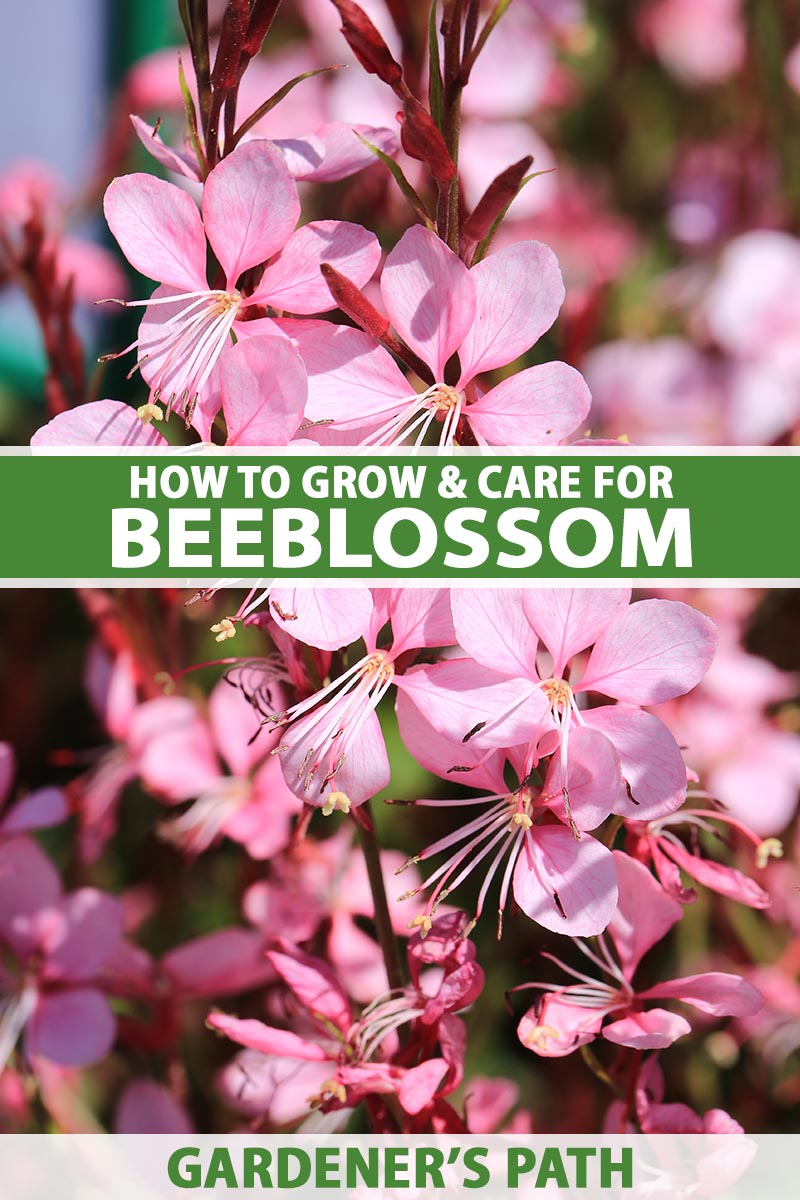
We link to vendors to help you find relevant products. If you buy from one of our links, we may earn a commission.
Waving in a breeze, the starry flowers look like clouds of butterflies, resplendent in shades of cherry to pale pink, white, and bicolor combos – and they have an exceptionally long flowering season, blooming profusely from early summer right until frost.
Plants branch densely, sending up masses of leaning stems that make lovely accents or specimens.
With casual grace, the tall species plants are simply spectacular when massed into small clumps or large drifts in cottage and wildflower gardens or xeriscapes.
And the compact dwarf cultivars are ideal for beds, containers, planters, or rock gardens.
The masses of bright flowers are a magnet for pollinators such as bees, butterflies, and hummingbirds but plants are resistant to herbivores like deer and rabbits.
A resilient, fast-growing perennial, gaura is indigenous to parts of the southern US where it thrives in high heat, hot soil, and humidity. Plus, plants feature good cold hardiness and excellent drought tolerance.
Are you ready for a showy, easy-care perennial that flowers for months? Then join us now and read along for all the details on how to grow and care for gaura!
Here’s what you’ll learn about up ahead:
What You’ll Learn
What Is Gaura?
Gaura, Oenothera lindheimeri, is an herbaceous perennial species that grows 15 to 60 inches tall and spreads up to 36 inches in dense, basal clumps.
Also known as beeblossom, butterfly flower, wand flower, and whirling butterflies, the long, wiry flower stems continue to elongate as they grow.
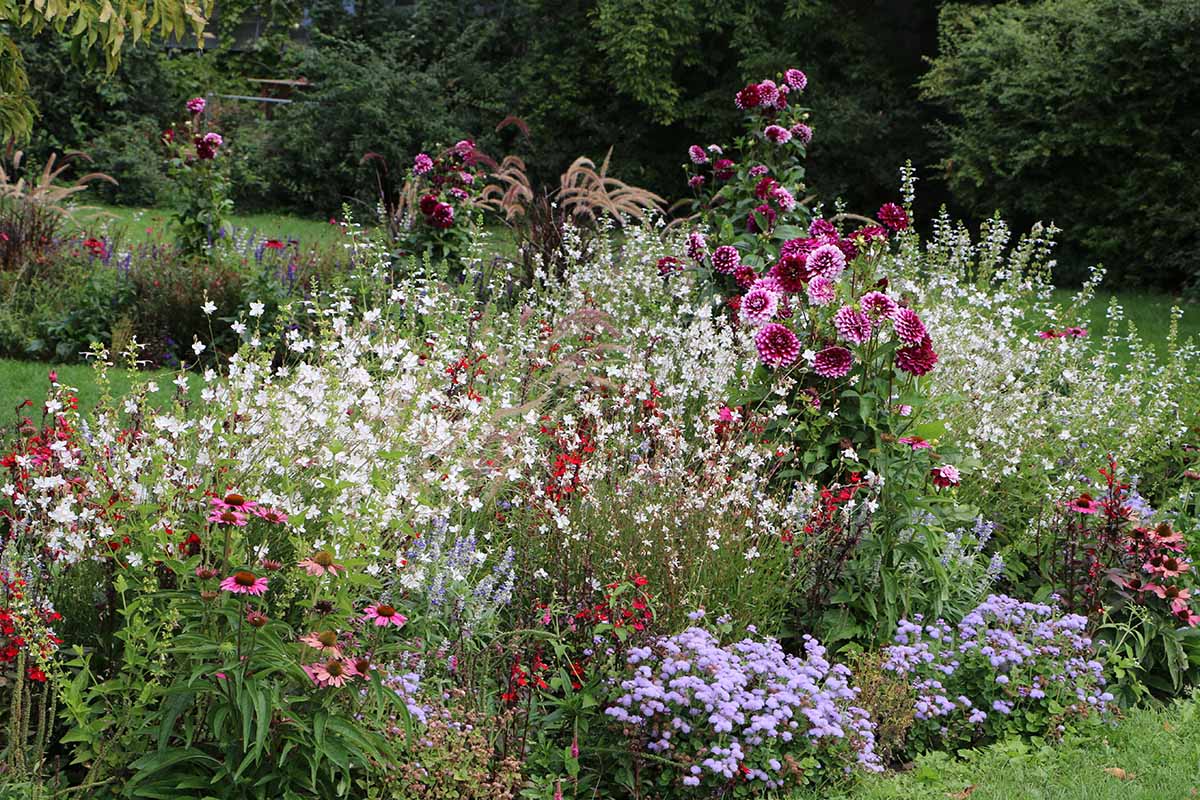
They’re continuously loaded with buds and delicate, one-inch, four-petaled flowers with a butterfly or starry shape in shades of deep cherry, pale pink, white, and bicolor combinations.
The dark burgundy-to-pink buds are borne on long, terminal panicles and open a few at a time, for a non-stop display of dancing blossoms.
The foliage is narrow and cup or lance-shaped, and depending on the cultivar, can be mottled or tinged in burgundy, or variegated with cream or gold.
Along with the masses of dainty, unscented flowers, a favorite feature is the long bloom time, which is among the best of garden perennials.
The heaviest flowering occurs in early summer, with repeat flushes throughout summer and another heavy bloom in early autumn. Flowering slows somewhat, but doesn’t stop, through the heat of high summer.
These hardy plants are native to full sun grasslands and prairies, growing in lean, well-draining soil with a gritty or sandy texture. They also form a long, thick taproot that gives them good drought protection.
The foliage dies back to the ground in a hard freeze but often remains evergreen in frost-free regions. New shoots are a little slow to emerge in spring and usually show up midway through the season.
Reliably hardy in USDA Zones 5 to 9, gaura is highly resilient to the elements and takes high heat and humidity in stride.
Cultivation and History
Native to Louisiana, Texas, and Mexico, gaura is a graceful prairie plant that sways in colorful clouds with a light breeze – and is aptly named from the ancient Greek word for majestic or splendid, gauros.
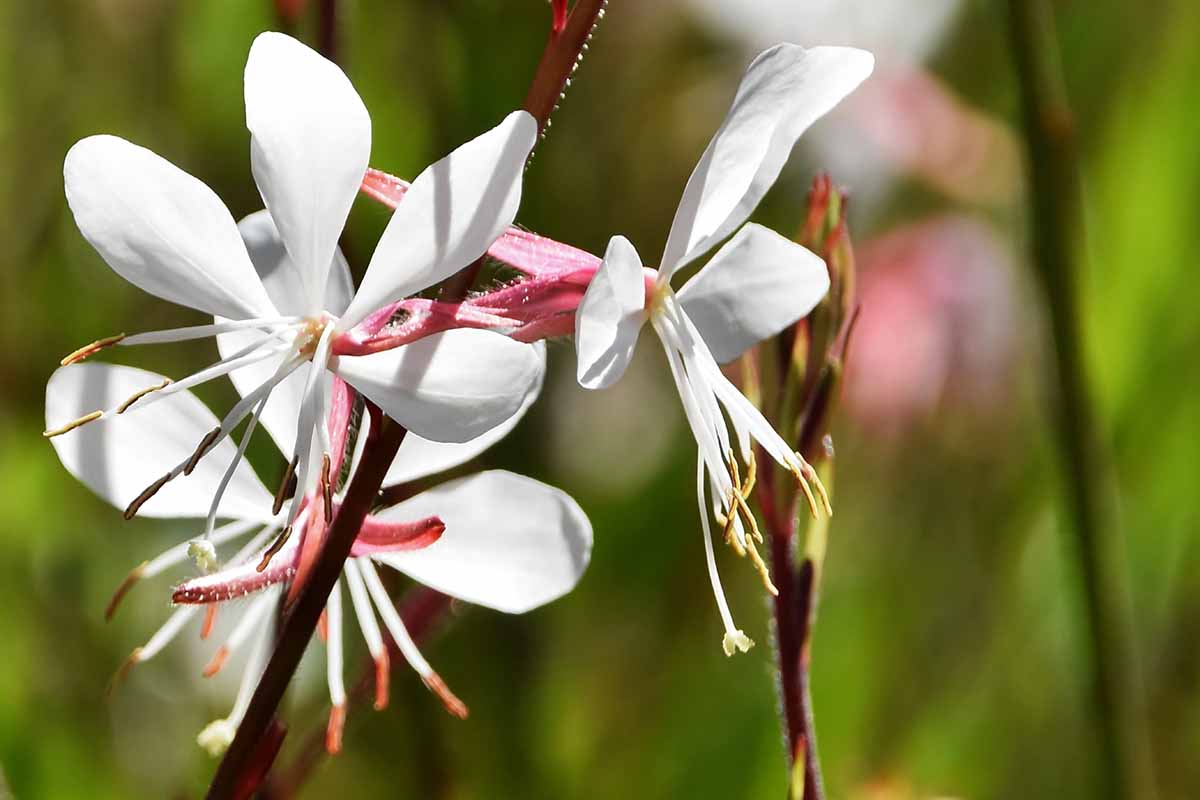
The species epithet lindheimeri is named after Ferdinand Jacob Lindheimer, a German-born botanist who collected primarily from the Texas frontier, becoming the first resident plant collector in the state.
As gaura increased in popularity for home gardens, in the early 1990s breeders introduced more compact cultivars with a tidier habit that are well-suited for beds, borders, and containers.
And as a result of taxonomic research, in the early 2000s Gaura species were moved into the genus Oenothera, and Gaura lindheimeri became Oenothera lindheimeri.
This species was awarded the Royal Horticultural Society’s Award of Garden Merit in 1993.
Gaura Plant Propagation
Gaura is easily propagated from seed or via basal and softwood cuttings in spring, or semi-ripe cuttings in summer. Division is difficult due to the taproot of these plants.
Basal or Softwood Cuttings
To propagate with basal or softwood cuttings, begin in late spring. Use a clean, sharp knife to cut five-inch shoots at the base of stems or remove five-inch sections from stem tips.
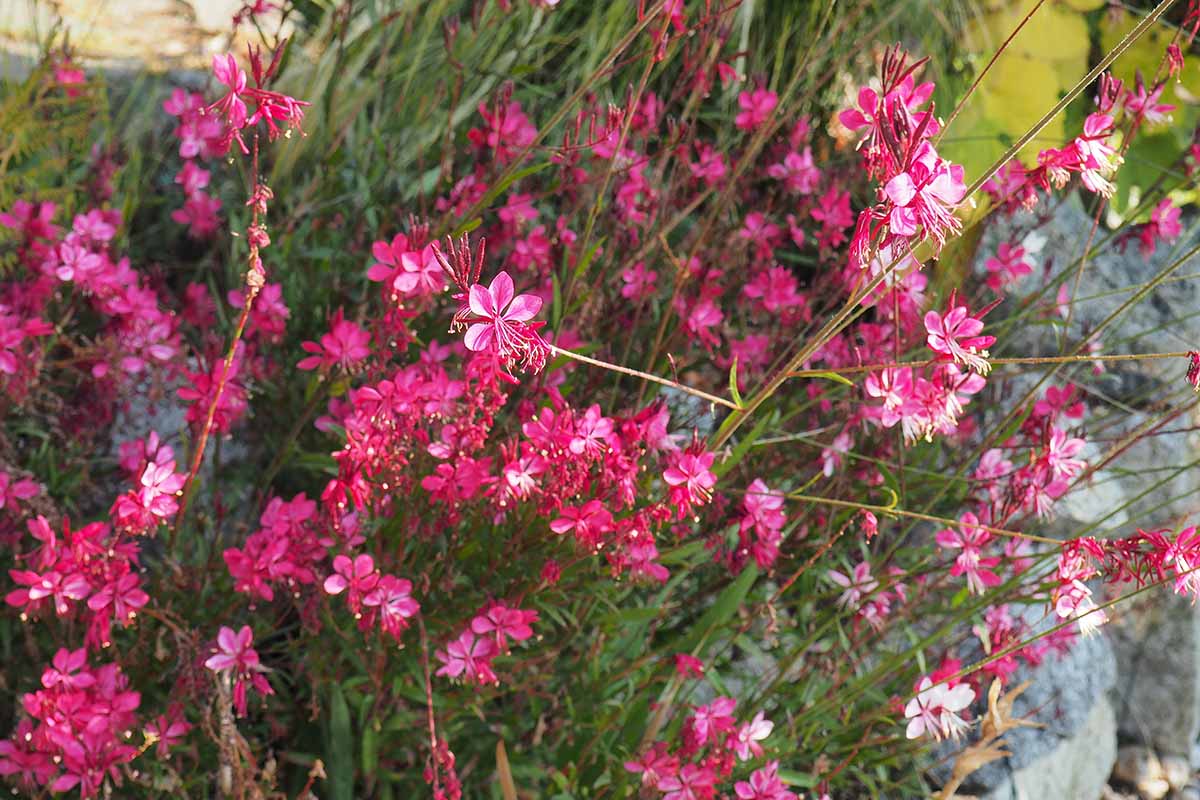
With basal cuttings, cut stems close to the crown, but not into it.
Cuttings from semi-ripe wood can be taken from non-flowering stems in summer.
Remove leaves from the lower half of the cuttings and dip in rooting hormone if desired.
Fill four- to six-inch pots with a finely textured starter soil.
Insert the stems up to the first set of leaves then gently firm the soil around them.
Water slowly until the soil is evenly moist.
Place pots in a protected outdoor location that provides afternoon shade.
Keep the soil lightly moist, watering as needed. Rooting takes place in four to six weeks, and new growth can take up to eight weeks.
After new growth appears, transplant into mid-sized containers about 10 inches tall and wide, keeping the soil lightly moist until plants are established.
Transplant spring cuttings into beds and containers in early July when plants have filled out.
Summer cuttings from semi-ripe wood are best transplanted out the following spring, allowing the roots to grow and develop over the fall.
From Seed
Gaura is easily started from seed and can be sown in spring or fall.
For flowers that bloom in the first year, start seeds indoors eight to 10 weeks before the last frost date.
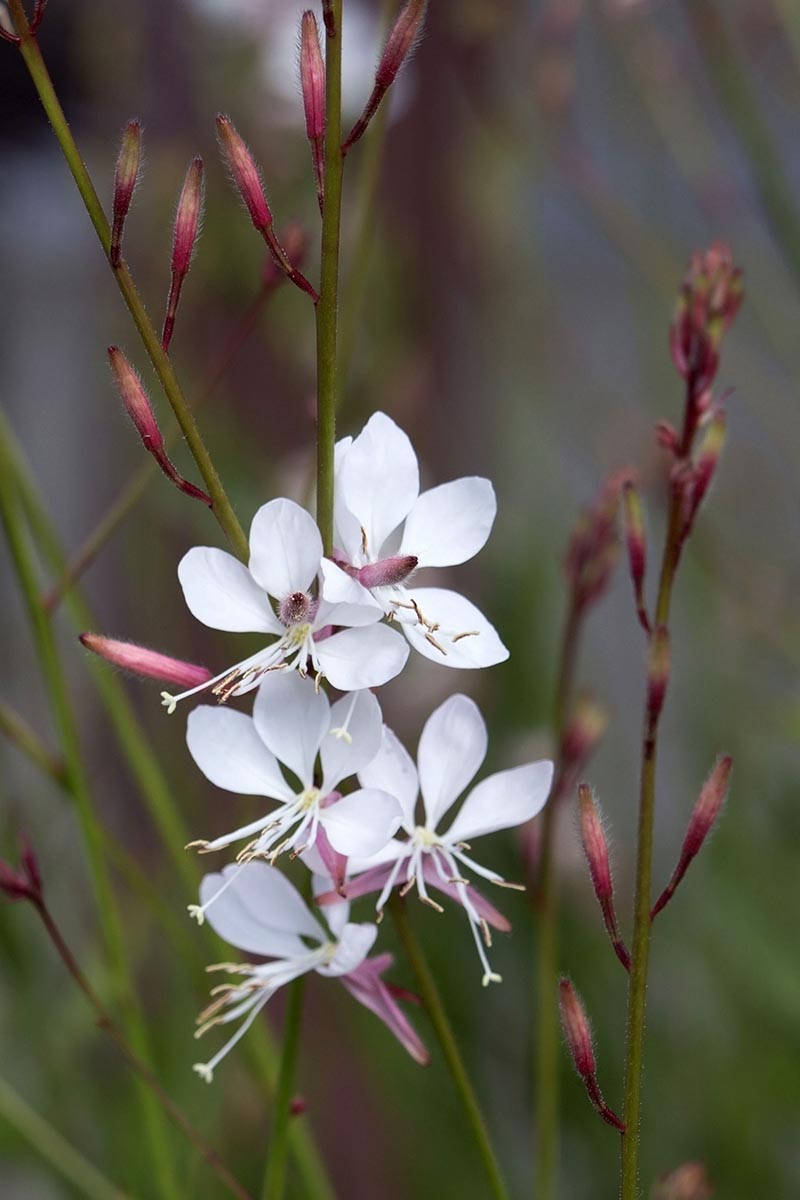
Fill cell flats, trays, or small pots with a light textured starter mix. Water the soil gently until evenly moist.
Sprinkle seeds evenly and barely cover with one-eighth of an inch of soil.
Place in a bright location and maintain temperatures between 65 and 75°F. Germination should occur in 14 to 30 days. Keep the soil moist.
When seedlings are six inches tall, cut back by half to encourage branching and compact growth. Transplant out into mid-sized containers in early spring.
Move into permanent containers or plant out in the garden in early July when plants are bushier.
For direct sowing, in spring after the danger of frost has passed or in early autumn, scatter seeds evenly over prepared soil and gently press them in. Cover lightly with soil and water to moisten.
Maintain soil moisture. When seedlings are six inches tall, cut them back by half to promote compact growth and branching.
Gaura also self-seeds readily and may naturalize in favorable conditions.
How to Grow Beeblossom Flowers
Although gaura adapts well to lean soil, it does best in fertile, well-draining soil with a neutral pH, tolerating slightly acidic to slightly alkaline soil with a pH ranging from 6.1 to 7.8.
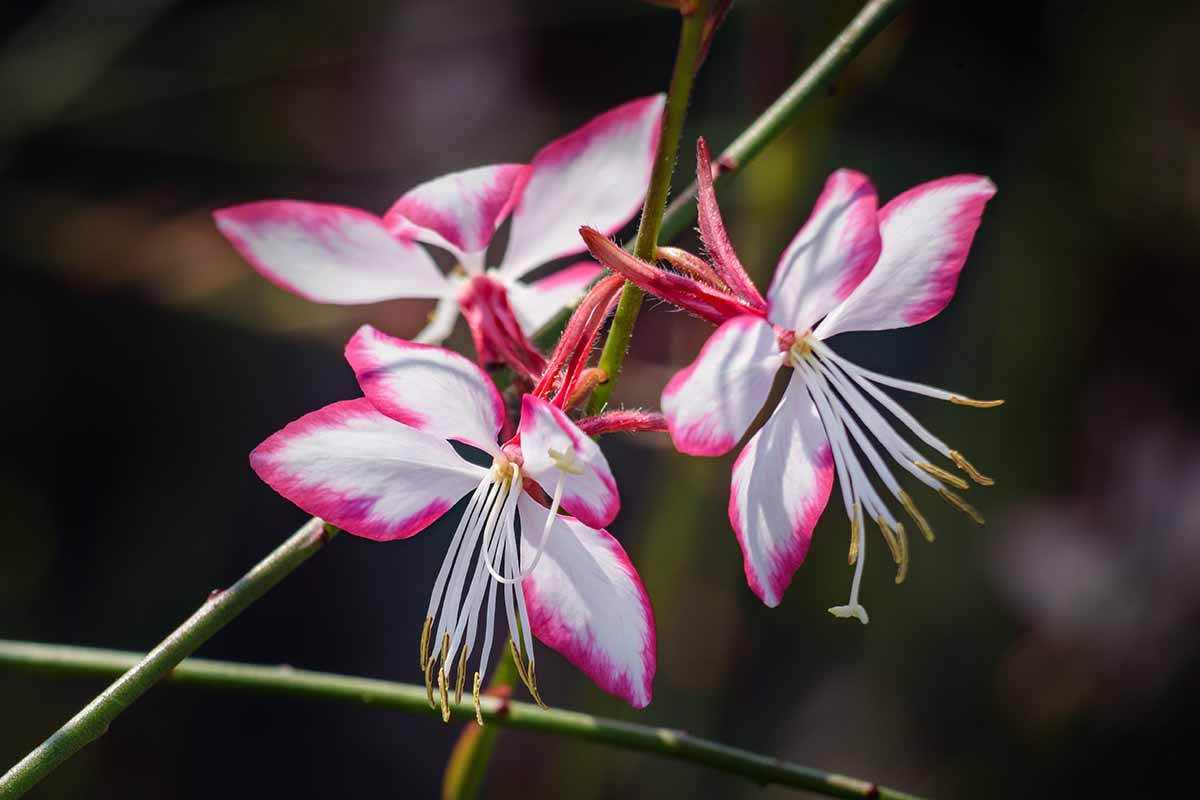
Plants can tolerate light shade, particularly in very hot areas, but flower best in full sun.
To prepare the planting site, in spring loosen soil to a depth of 12 inches then mix in a shovelful of compost or well-rotted manure.
Avoid adding too much organic material as plants can become leggy in soil that’s too rich.
To avoid root rot from wet soil, amend with a shovelful of granite chips, landscape sand, or pea gravel to improve drainage as needed. Or plant in a raised bed in areas with heavy winter moisture.
Mix in a tablespoon or two of bone meal to help establish strong, healthy roots.
Set new transplants in place with the crown above the soil line, spacing them 12 to 36 inches apart, depending on the cultivar.
Backfill with soil and firm lightly then water gently to settle.
Water weekly until plants are established, allowing the top inch of soil to dry out between applications.
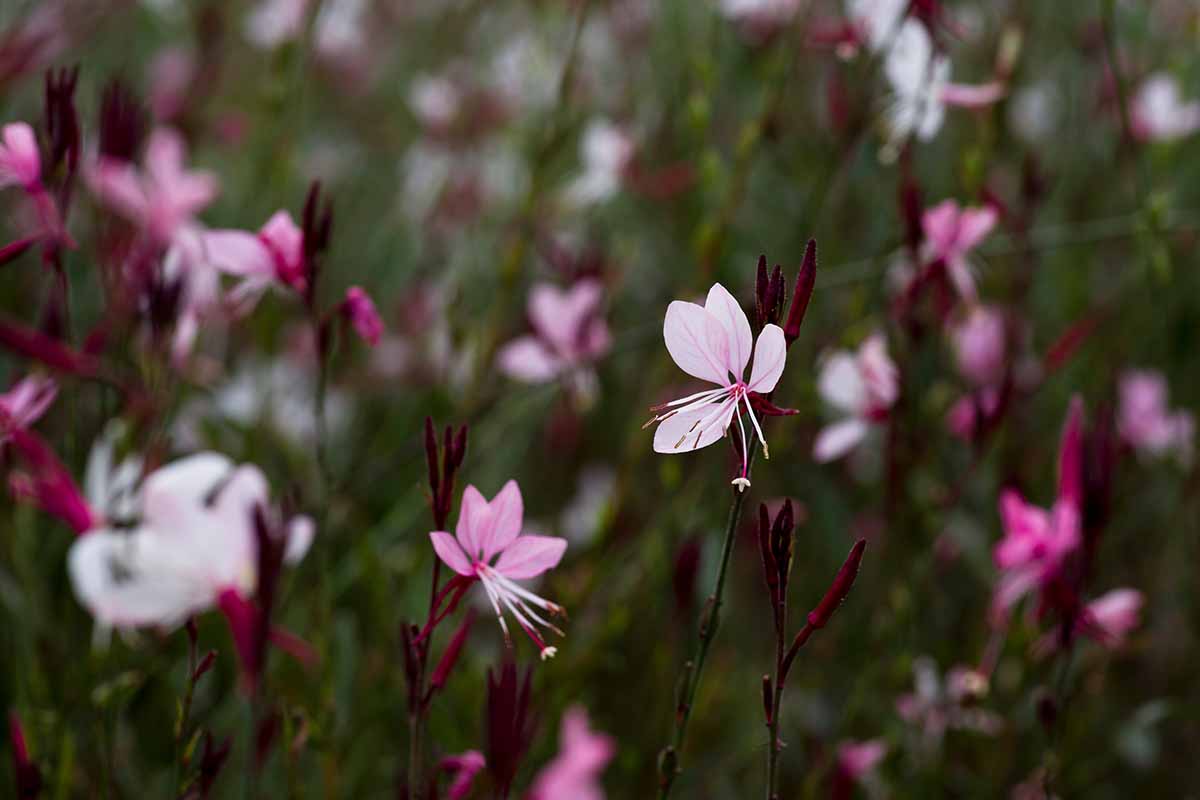
Once established, water only in dry conditions, allowing the top two to three inches of soil to dry between applications and watering deeply to ensure all roots receive moisture.
Also, it may be difficult to keep large species plants upright, especially after rain, and they can benefit from nearby perennials to prop them up.
Use low-growing woody or semi-woody plants as “shoulders” that can support the leaning wands, such as azaleas, lavender, sage, spirea, rosemary, or viburnum. Place them 12 to 18 inches in front of the gaura for support.
Container Growth
For containers, use pots at least 12 inches tall to accommodate the long taproot.
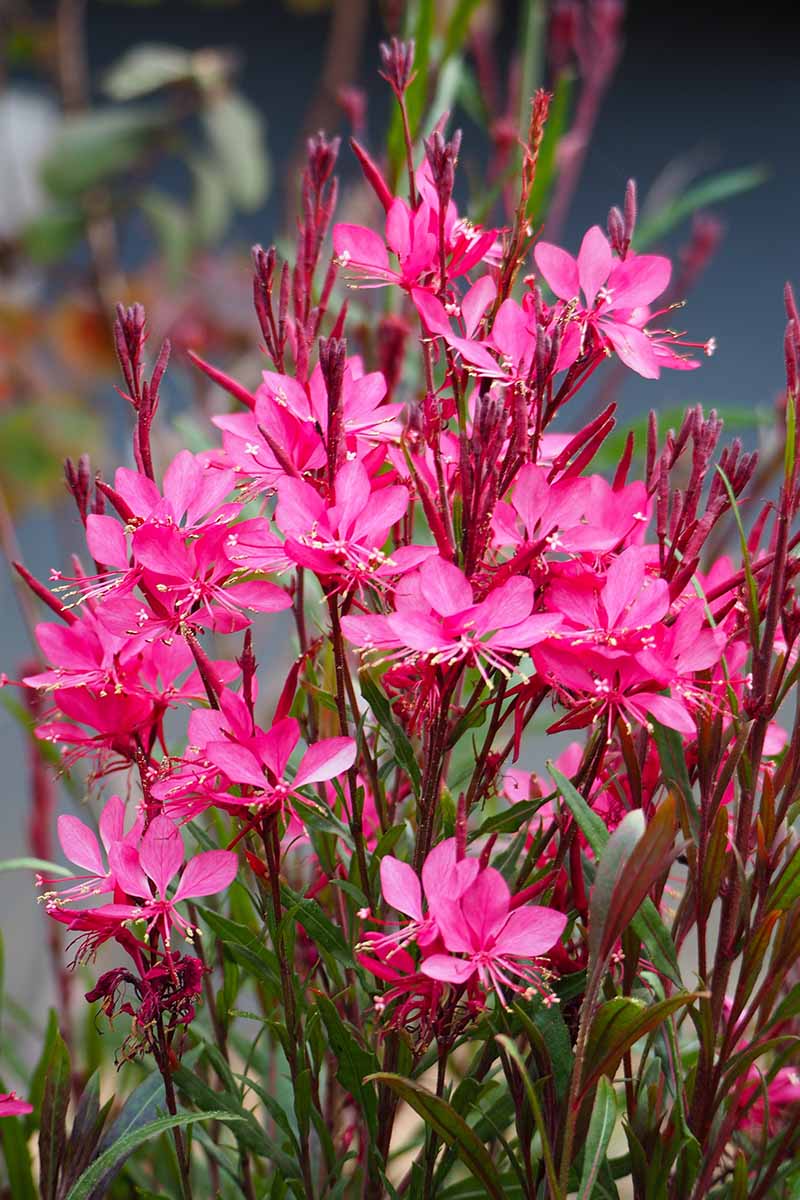
Ensure containers have drainage holes. I cover the base with a two-inch layer of drainage materials such as broken pottery or pebbles.
Fill containers with a fertile soil with a sandy or gritty texture and mix in one to two tablespoons of bone meal.
Set plants in place then backfill with soil, keeping the crown above the soil line. Gently firm in place.
Locate containers and planters in a sunny spot and water when the top two inches of soil are dry.
Growing Tips
Gaura is low maintenance and easily cultivated, and the following tips help ensure robust, healthy plants:
- Although they’re drought tolerant, gaura flowers best with regular moisture. Soak the roots of mature plants slowly and deeply when the top two to three inches of soil dry out.
- Support large cultivars and keep them upright with low-growing woody perennials to shoulder leaning wands.
- Choose dwarf cultivars for beds and borders and use full-sized ones where they can spread or freely naturalize.
- Thanks to their location of origin, gaura shines in hot, humid climates and make a welcome addition to gardens with similar conditions.
Now let’s look at how to prune and maintain beeblossom for outstanding displays.
Pruning and Maintenance
Although deadheading isn’t necessary, for a longer growing season, cut back the flower stems in midsummer to spur reblooming in two or three weeks.
This also helps to keep larger varieties tidy and compact.
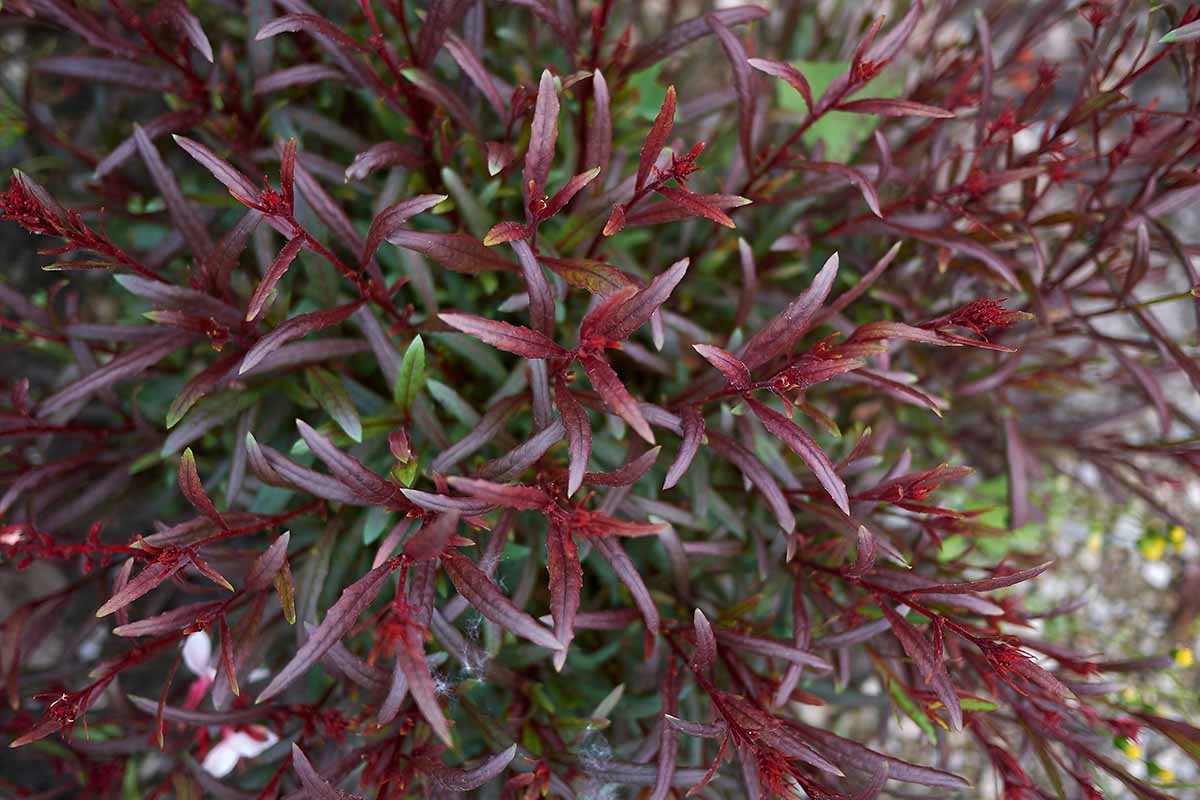
After the first hard frost, or after flowering has finished in frost-free zones, cut back all the foliage to the ground and clean up any debris to prevent pests from overwintering.
If you’re gardening in a frost-free area where the plants remain evergreen, cut them back hard in early spring to eight inches to promote compact, bushy growth.
To promote compact growth with abundant flowers, fertilize sparingly.
In soil that’s too rich, or when plants are overfed, they can become leggy or the long flower stems may flop.
In spring, once new growth emerges, apply a two-inch layer of compost over the root zone, keeping it clear of the crown to avoid trapping moisture.
An alternative to compost is to scratch in a slow-release fertilizer in mid-spring, using an all-purpose formula such as 20-20-20 NPK.
For container plants, add a second feeding in midsummer.
To reduce self-seeding or to maintain a tidier, more compact form, use clean, sharp shears to cut back plants by up to half in late spring. At the same time, selectively remove some of the outer stems close to the ground to reduce overall girth.
For gardens in Zone 7 or colder regions, provide plants with a four- to six-inch layer of mulch to protect the roots against freeze and thaw cycles.
Use free-flowing materials such as small pebbles or pea gravel to avoid issues like root rot. Container plants should be moved into protected sites and insulated against the cold.
If containers are moved into areas with no rain, like an unheated garage or shed, water lightly once a month to keep the roots alive. But don’t water if the soil is frozen.
Gaura self-seeds readily and seeds can be collected from midsummer on, but many hybrid varieties won’t produce true to the mother plant.
To ensure offspring are as attractive as the parent, propagate cultivars using the stem cutting method outlined in the propagation section above to produce clones.
Beeblossom Cultivars to Select
A beautiful species plant, native gaura (O. lindheimeri) has a large, open habit – like its southern grassland home.
The long, graceful stems are loaded with rosy pink buds, opening into fluttering white flowers that fade into pink as they age, then deepen to rosy pink before dropping off.
The lance-shaped, mid-green foliage darkens somewhat in fall and plants flower steadily from early summer to frost.
These vigorous plants form sizable clumps of 24 to 48 inches tall with a 24- to 36-inch spread and look magnificent grouped into large drifts, meadows, and butterfly, cottage, or wildflower gardens. It’s hardy in Zones 5 to 9.
Native gaura seeds are available at Walmart.
There are also several beautiful gaura varieties to choose from, and all have a good tolerance for drought, heat, and humidity. Here are a few suggestions to get you started.
Gambit
A compact, mounding plant, ‘Gambit’ features waves of hot pink, starry flowers borne on upright stems from early summer into autumn.
The narrow, lance-shaped leaves are variegated cream and dark green, and heavily flushed with maroon in spring and again in autumn.
A beautiful selection for beds, borders, containers, and in wildflower or prairie plantings, ‘Gambit’ has a mature height of 16 to 20 inches and spreads 12 to 16 inches. It’s hardy in Zones 6 to 9.
Plants are available at Burpee.
Rosy Jane
A compact, eye-catching performer ‘Rosy Jane’ features masses of bicolor blooms from early summer into early autumn. These have a white base with bubblegum pink picotee edging.
The floating flowers hover above handsome, dark green foliage that’s splashed with purple and takes on redder tones in the cool of autumn.
Dense and trim with clouds of color, ‘Rosy Jane’ has a mature height and spread of up to 24 inches.
The compact size and long season make this variety ideal for borders, containers, edging, and rockeries, or it may be massed in small groups to large drifts. Hardy in Zones 5 to 9.
Plants are available at Burpee.
Siskiyou Pink
A bicolored beauty, ‘Siskiyou Pink’ displays flowering stems with a beautiful combination of maroon buds that open to pretty pink. It flowers all summer and into fall.
The bright green foliage is lightly mottled with burgundy and takes on deep red shades in autumn.
‘Siskiyou Pink’ has a height and spread of 24 to 36 inches and makes a reliable, eye-catching addition in beds, foundations, islands, and cottage gardens, or when paired with other native flowers and grasses in wildflower gardens.
This cultivar does not self-seed and is hardy in Zones 5 to 9.
Plants are available at Nature Hills Nursery.
Managing Pests and Disease
Gaura plants are generally easy-care, but there are a few issues to watch for.
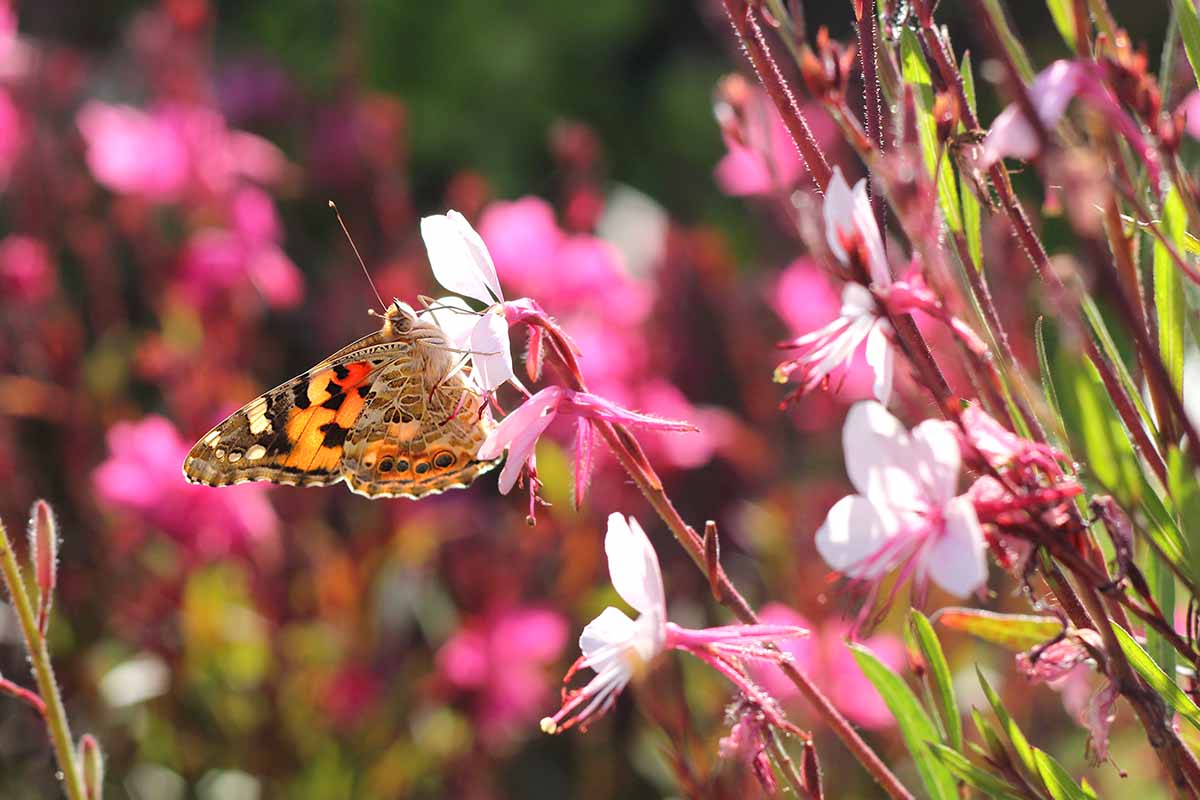
The most common pests are sapsuckers, like aphids, along with spider mites and whiteflies, causing problems such as galls on stems or foliage that bleaches, curls, or yellows.
Aphids and spider mites can often be dispatched with a strong stream of water from the garden hose but they can reappear – check plants every two or three days and repeat spraying until they stay away.
For more serious infestations of aphids or mites, and for whiteflies, an insecticidal soap may be needed to resolve the problem.
Soaps with natural neem oil can be an effective solution for these pests – Neem Max from Bonide can control all three and is available at Arbico Organics.
Bonide Captain Jack’s Neem Max
Beeblossom’s long taproot can be susceptible to rot when grown in heavy or wet soil. Ensure plants are set in a well-draining medium or plant in raised beds to improve drainage.
Fungal problems such as powdery mildew, a white or gray fuzzy mold, and rust – brown to rust-colored boils – can cause stem collapse, yellowing foliage, and overall decline.
The aforementioned Neem Max is also an effective fungicide and it can be used to treat these problems as well.
Best Uses for Gaura Flowers
The loose, airy appearance of species gaura is well suited to informal settings and mixes well with annuals, grasses, and other perennials.
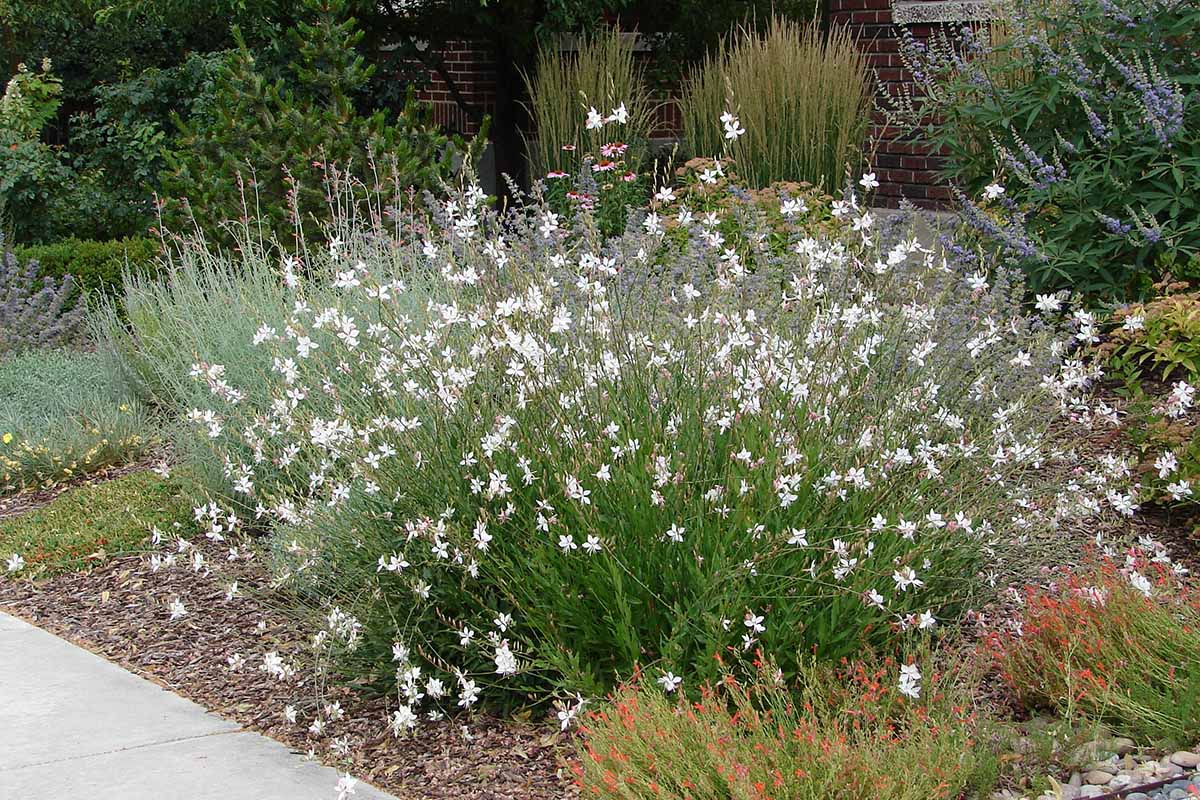
Add beautiful color and movement to mixed beds, containers, foundations, islands, and in butterfly, cottage, and naturalized or wildflower gardens.
Dwarf cultivars are more contained in their growth and better suited for borders, patio planters, and rock gardens.
For dramatic effect, cluster into small groups or large drifts. Or mix them into a native wildflower group with the likes of echinacea, gaillardia, or liatris.
And with their long flowering time, they make an excellent addition to the fall garden to compliment asters and chrysanthemums.
A recent addition in my Zone 9 garden, gaura has quickly become a favorite for its consistently abundant and steady flower production over summer and into early November, when frosty nights arrive.
Not only does it produce bright, bold flowers, the foliage deepens and darkens in fall, morphing from burgundy-tinged to full-on burgundy, wine red, and purple tones – a real showstopper in the autumn garden!
Quick Reference Growing Guide
| Plant Type: | Herbaceous flowering perennial | Flower / Foliage Color: | Cherry to pale pinks and white/green, green splashed with maroon, variegated cream and green |
| Native to: | Louisiana, Texas, Mexico | Tolerance: | Deer, drought, lean soil, rabbits |
| Hardiness (USDA Zone): | 5-9 | Maintenance: | Low |
| Bloom Time/Season: | Summer, fall | Soil Type: | Average amended lightly with compost |
| Exposure: | Full sun | Soil pH: | 6.1-7.8 |
| Time to Maturity: | 100 days (seed) | Soil Drainage: | Well-draining |
| Spacing: | 12-36 inches, depending on the variety | Attracts: | Bees, butterflies, hummingbirds |
| Planting Depth: | 1/8 inch (seeds), crowns just above soil line (transplants) | Uses: | Butterfly and cottage gardens, foundations, islands, naturalized plantings (species); beds, borders, containers, rockeries (dwarf cultivars) |
| Height: | Up to 60 inches (species), 20-36 inches (cultivars) | Order: | Myrtales |
| Spread: | Up to 40 inches (species), 16-24 inches (cultivars) | Family: | Onagraceae |
| Water Needs: | Low once established | Genus: | Oenothera (syn. Gaura) |
| Common Pests and Diseases: | Aphids, spider mites, whiteflies; powdery mildew, root rot, rust | Species: | Lindheimeri |
Whirling Delights
With airy, casual charm, loads of dancing flowers, and a long flowering season, gaura is sure to please in any garden!
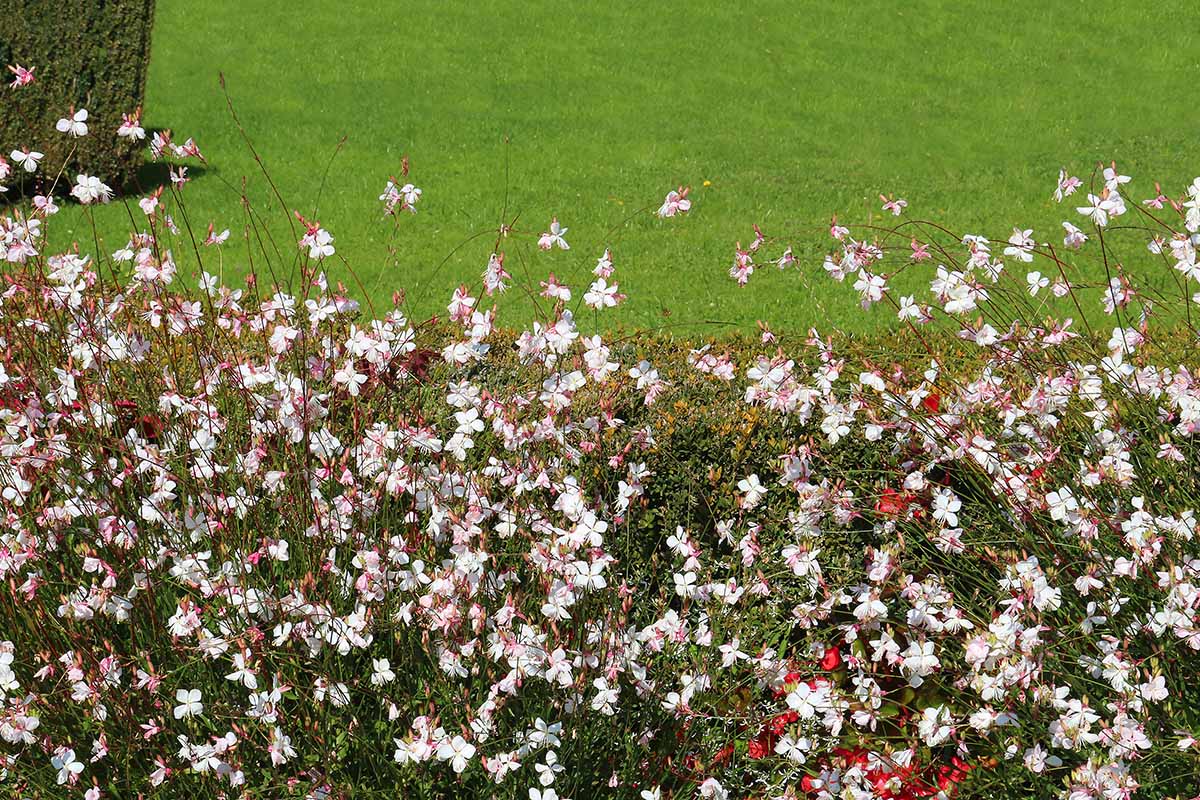
For the best performance, be sure they’re planted in full sun with well-draining soil. And for upright plants with plenty of flowers, don’t over-fertilize.
Use the taller species plants in roomy settings where they can sway and dance at will, and the smaller dwarf varieties for more restricted growth – whichever you choose, you’ll love their delightful, whirling flowers.
How do you folks use gaura in the garden? Tell us about it in the comments section below.
And for more native flower selections, be sure to read these guides next:
